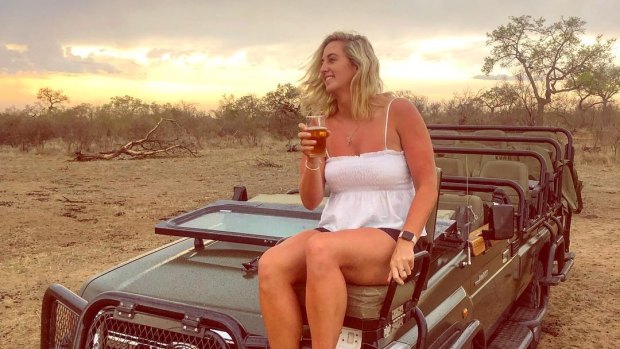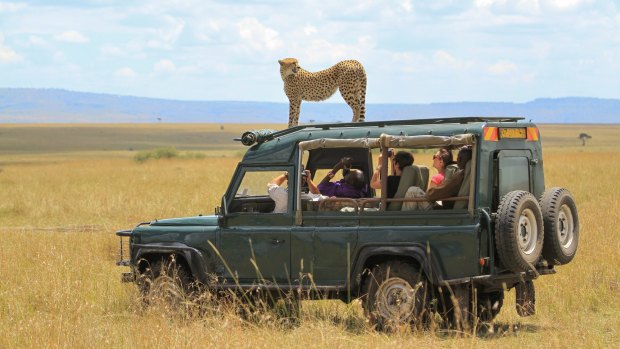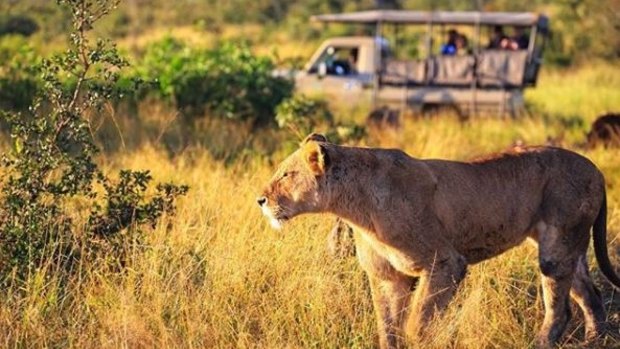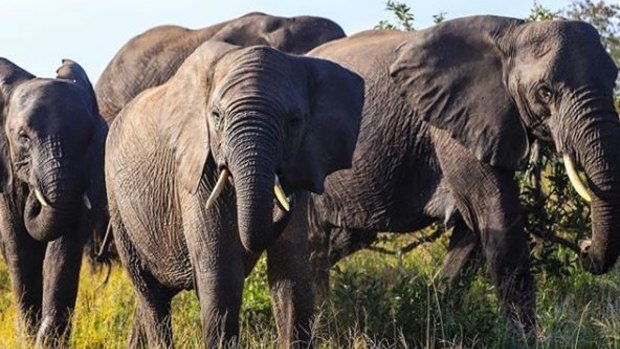This was published 5 years ago
Why South Africa is the best place to go on your first safari
By Kylie McLaughlin

Sundowners on safari.
Exactly how much sleep can you get knowing there is nothing but a sheet of canvas separating you from some of the world's most dangerous animals?
Not much, I realised on my first night of safari, as an indescribable howl periodically breaks the night's silence.
I get up the the sound of drums pounding at 6am and wait for my escort to the campsite's restaurant to begin our morning safari where we're surrounded by a troupe of cheeky vervet monkeys who are momentarily distracted from biscuit-stealing to create a cacophonous humdrum. Our guide tells us they've spied something dangerous lurking around the campsite. The lurker is a huge tan-coloured leopard, who slinks straight past the camp's watering hole paying absolutely no mind to us who stand, mouths agape, as it disappears into the reserve's tangled bushes.

A cheetah attempts to get a better view of his lunch.Credit: Shutterstock
We try to track it during morning safari, but the leopard has long gone.
We're only at Honeyguide for two nights but over four safaris - two early morning, and two in the evening - we manage to see a broad spectrum of animals and action, starting with two prides of lions burying the hatchet for a family picnic, where a huge giraffe is the unfortunate creature on the menu. A dozen lions lie over its huge ribcage sleeping, gnawing and growling over its huge, stinking carcass. By day two, two male lions have chased the prides away and now sit guarding the sorry-looking carcass, yellow eyes glaring at us menacingly as we drive worryingly close by, while hyenas and vultures wait nearby for the scraps. Unfortunately, it was to be this safari's only giraffe sighting.
Later, our guide spies the limbs from a leopard cub hanging from a tree branch, its golden coat dazzling in the afternoon sunlight; and we also see two cheetahs scanning the horizon for their next meal from a sandy hill. Princely zebras stand poised, ready for a photoshoot, foals hiding shyly behind their feet, while impalas leap playfully over fallen trees.

Lioness on a Honeyguide safari.Credit: Kylie McLaughlin
On a third trip, a baby black rhino is closely guarded by its mother amongst the bushes. We spy two sets of eyes belonging to hippos bulge over a lake's surface while a crocodile slides into the water at a nearby. There's countless wildebeest and buffalo, graceful kudu, wide-eared and delicately marked; as well as brightly-coloured birds zipping from tree to tree.
There's plenty more action back at our campsite, which one guide nicknames 'the superhighway of Kruger' because of its placement right in the national park's centre. Three elephants are regular visitors for water; they're not friendly, though, and stare meaningfully at us tourists, and they mean business - charging two members of the group who dared to get too close. At night, there's a lot more visitors you may not wish to run into, such as lions. We're not allowed to leave the tents without a guide.
Our last afternoon safari drive is cut short and we're sent back to the campsite as a couple of wild African dogs have caught an impala right in the camp's centre, by the purpose-built watering hole.

Don't mess with African elephants.Credit: Kylie McLaughlin
The dogs - also nicknamed 'painted wolves' - have oversized curvy ears and their mottled yellow, black and white markings look like they've had a run-in with an abstract artist.
The dogs trot around our campsite rather innocently and canine-like, before following the sunset, forgetting us, the camp, and what remains of its dinner. Or so we think.
After an extended session of Africa's famous safari sundowners our group tumble into bed late, dogs forgotten, until I am rudely awakened by the unmistakable sound of an animal crunching on what could only be bone. And it's right. Outside. My. Tent.
Not wanting to come between the dog and what's probably left of the impala, I lie in a semi-paralytic state in bed, when another unearthly noise erupts, followed by what sounds uncannily like a human laugh.
I recognise the first sound from the first night. The second could only be that of a hyena. The dogs have the mechanics to chew on bone as do the hyenas and fight over the remains. An elephant trumpets lowly from across the campsite. It's probably had it's good night's sleep ruined, too.
Eventually morning breaks and I peek outside the tent to see what's going on, fearing leftovers of impala carcass piled outside my door. But there's only a huge pile of elephant dung, a few animal tracks and the wild dogs, running, mercifully, away from me.
All these amazing animal encounters are book-ened by atmospherical sunrises and sunsets; which at this time of year turn the skies a candy-cane pink as mist envelopes the green foliage, which in South Africa means it's time for another sundowner, followed by another thrilling - if not a little uneasy - night's sleep.
See also: The country that's probably not on your bucket list (but it should be)
See also: What happens when a giraffe shows up for breakfast, every day
TRIP NOTES
MORE
STAY
Honeyguide Khoka Moya & Mantobeni Camps,Manyeleti Game Reserve, Orpen Gate, Mpumalanga, Ph: +27 15 793 1729; honeyguidecamp.com
FLY
Qantas flies directly to Johannesburg from Sydney daily, qantas.com
South African Airways flies from Perth daily, connecting travellers from Melbourne and Sydney with Virgin. flysaa.com
The writer was a guest of Visit South African Tourism
Sign up for the Traveller Deals newsletter
Get exclusive travel deals delivered straight to your inbox. Sign up now.